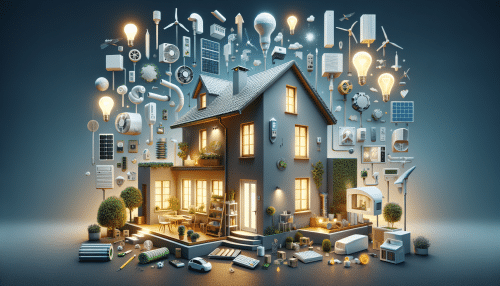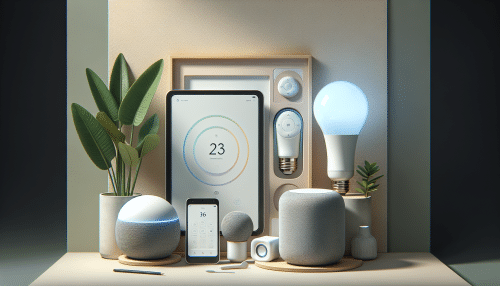Secrets to Energy Efficient Homes You Might Overlook
Olivia Morgan November 7, 2025
Discover how energy efficient home improvements can lead to lower utility costs, greater comfort, and a lighter carbon footprint. This guide explores proven ways to boost insulation, reduce drafts, use smart technology, and maximize returns on easy changes for your living space.
Understanding Energy Audits for Home Efficiency
Many homeowners seek out guidance for making their homes more energy efficient, but do not always know how to start. A professional energy audit is often the first step. This service evaluates areas such as insulation, seals, doors, and windows for potential air leaks and other inefficiencies. Through specialized tools and expert insight, energy audits reveal both small and large leaks in places you might overlook—like attics, basements, or even hidden gaps in old flooring. Discovering these details can be quite eye-opening and is the key to targeted improvements that pay off over time. Modern energy audits can also suggest which upgrades may yield the highest energy savings and comfort improvements in relation to their cost. (Source: https://www.energy.gov/energysaver/professional-home-energy-assessments)
After an audit, residents often find that fixing simple air leaks with caulk or weatherstripping can significantly reduce energy loss. Even the smallest gaps add up to high annual heating or cooling expenses. Comfort improves, too, as drafts vanish and room temperature becomes much more even throughout the home. Air leaks don’t always cause obvious discomfort, so many live for years unaware of how much money is lost through these tiny trouble spots. Addressing them can make a significant difference in both utility bills and overall home satisfaction. (Source: https://www.energystar.gov/campaign/home-improvements)
Energy audits not only evaluate loss but help determine priorities for upgrades, such as attic insulation vs. window replacement. By reviewing current utility expenses and usage patterns, an audit gives homeowners a sense of where the greatest improvement per dollar can be found. Some local utility companies offer these audits at reduced rates, and occasionally rebates are available for recommended upgrades. Exploring these opportunities can help make the transition to a more energy-efficient lifestyle even more affordable. (Source: https://www.energy.gov/eere/buildings/home-energy-audits)
Insulation: Where Home Comfort Starts
Insulation is the backbone of a comfortable, efficient home. Whether it’s installed in attics, walls, or under floors, good insulation slows the transfer of heat. That means fewer temperature swings inside and less stress on heaters or air conditioning. A home with proper insulation feels stable—warm in winter, cool in summer, and resistant to extreme outdoor changes. Without it, even the best HVAC systems can’t keep up, leading to fluctuating comfort and rising bills. Techniques have advanced; options now include blown-in cellulose, spray foam, and traditional fiberglass. The right type for each part of your home depends on existing structure and budget, but all offer solid improvements for energy conscious owners. (Source: https://www.energy.gov/energysaver/weatherize/insulation)
Some insulation efforts are surprisingly accessible. Adding new layers in attic spaces is a high-impact project most homeowners can tackle or coordinate with a contractor at moderate cost. It is often rated as one of the most cost-effective energy improvements available, with a rapid return on investment through lower utility bills. Other overlooked spots include crawlspaces and basement rim joists, where air and moisture mean cooled or heated air get lost fast. Insulation in these areas not only cuts costs but also helps prevent moisture issues and air quality concerns, enhancing the overall living environment.
Insulation’s benefits go far beyond just utility savings. It dampens noise from both outdoors and between rooms, leading to quieter, more peaceful spaces. For those in dense neighborhoods or by busy roads, this can make a surprising difference. There’s also a health aspect: by reducing drafts and temperature variability, insulation can help limit mold growth and deter pests who often seek out easy entry in poorly sealed places. Good insulation is a foundation for comfort, energy savings, and a healthier home. (Source: https://www.epa.gov/indoor-air-quality-iaq/insulation-materials)
Windows and Doors: Smart Upgrades That Matter
Windows and doors are more than just aesthetic features; they play a crucial role in temperature regulation. Old or single-pane windows allow significant heat loss in winter and heat gain in summer. Upgrading to double- or triple-pane options, or even storm windows, can greatly improve efficiency. Even upgrading frames with proper seals and gaskets helps prevent invisible energy leaks. For those on a budget, applying clear plastic film to old windows in cold months serves as an effective temporary shield. Proper door sweeps and weather stripping on exterior doors also block drafts, contributing to a more controlled indoor environment year-round. (Source: https://www.energy.gov/energysaver/design/windows-doors-and-skylights)
If full replacement isn’t feasible, there are creative steps to improve efficiency of existing windows. Adding thick, insulated curtains or cellular shades can trap warmth and provide privacy. Window caulking can be reapplied each year to seal cracks created by seasonal expansion or movement of building materials. Some manufacturers also offer retrofit window films that block UV and infrared rays, cutting down both glare and unwanted heat. These options allow homeowners to achieve significant energy savings and comfort improvements with minimal investment and effort.
Doors are often forgotten but can be a major source of heat loss. A properly fitted door with quality weatherstripping maintains interior air quality and comfort. When old doors are replaced, especially in strategic locations like entryways or rear exits, many families notice fewer cold spots and reduced noise. Solid-core or insulated doors have proven to add another layer of protection. The investment quickly pays back through consistent comfort and lower annual utility expenses. A well-placed upgrade can have far-reaching effects on the overall feel and efficiency of the home.
Smart Home Technology for Energy Savings
Home automation is transforming the way homeowners manage energy efficiency. Smart thermostats, for example, actively learn daily routines and adjust heating or cooling accordingly. This means no more waste from accidentally leaving HVAC systems running all day, and optimized comfort for every part of the household. Many models can be controlled remotely, allowing real-time adjustments from anywhere using a smartphone or voice assistant. Research consistently shows smart thermostats can save on average between 10%-12% on heating and up to 15% on cooling bills each year. (Source: https://www.energy.gov/energysaver/smart-thermostats)
Smart lighting is another straightforward way to reduce wasted energy. LED bulbs use significantly less electricity than traditional incandescent and last much longer, sometimes more than ten years. Pairing LEDs with motion sensors or automated schedules can ensure that lights are only on when and where they are needed. For larger homes, zoned controls let households manage lighting room by room from a central app or smart hub, leading to consistent savings. Some systems can even simulate occupancy when residents are away for added security. Technological upgrades bring comfort, convenience, and efficiency together, making the modern home smarter in every way.
Beyond thermostats and lighting, a range of smart plugs, power strips, and sensors offer further savings. Appliances and electronics that draw power even when “off”—known as vampire loads—can account for substantial wasted electricity. Smart plugs can cut power completely or schedule use around daily habits for computers, TVs, and small appliances. Over time, reducing vampire loads further trims utility costs and enhances the overall resilience of your home’s energy footprint. Every advancement in home automation makes the dream of a sustainable household more achievable and accessible than ever before.
Practical Lifestyle Changes That Make a Difference
Small adjustments in daily routines lead to noticeable savings over time. Simple actions like setting thermostats lower in winter and higher in summer can add up to significant reductions in utility bills. Layering clothing indoors or using ceiling fans before turning on the air conditioner helps take advantage of natural comfort methods. Similarly, making sure lights are turned off in unused rooms and unplugging chargers when not in use may seem minor but cumulatively save a surprising amount of energy. These habits adapt the home to both the seasons and the regular flow of everyday life.
When running appliances, some strategies can decrease energy use without sacrifice. Washing clothes in cold water, air drying when possible, and waiting to run full dishwasher loads are simple ways to cut usage. Scheduling laundry and other appliance-heavy chores outside of peak utility rate hours—if your provider uses time-of-use pricing—can also save money. These steps are painless, and as energy costs rise, the savings become more apparent. Incorporating even a few habits into daily routines fosters a culture of efficiency that the whole household can support.
Water usage directly impacts energy bills as well. Installing low-flow showerheads, fixing leaky faucets, and using efficient laundry machines all help conserve both water and electricity. Regular maintenance of water heaters and considering newer tankless options can make further improvements. Ultimately, mindful use of resources—electricity, water, and even natural light—translates into a more resilient, lower-cost, and comfortable living space. By practicing small changes, residents turn energy efficiency into a lifestyle rather than an occasional project.
Renewable Energy Options for Homeowners
Adopting renewable energy sources, such as solar panels or geothermal heat pumps, is increasingly attainable for homeowners interested in the ultimate step in efficiency. While installation comes with upfront cost, incentives and rebates—often from state or federal sources—help offset the investment. Solar panels capture sunlight and convert it into usable electricity, lowering reliance on the grid. Over the long term, these investments can produce excess power that’s sold back to utilities, generating credits that cut monthly bills and sometimes provide extra income. (Source: https://www.energy.gov/eere/solar/homeowners-guide-going-solar)
Geothermal systems use the earth’s constant underground temperature to heat and cool a home far more efficiently than traditional setups. These systems are especially effective for those building new homes but can be retrofitted as well. Though the initial expense is higher than conventional models, low operating costs and potential subsidies shorten the payback period. Homeowners with geothermal systems report stable, predictable utility expenses and a smaller carbon footprint, making them an attractive long-term investment for both savings and sustainability.
Even if large installations aren’t an option, there are ways to support renewable energy adoption. Some utility providers offer green power programs, allowing residents to choose a portion of electricity from renewable sources for a slight premium. Community solar projects can also let individuals buy shares in a larger solar array in their area. These alternatives extend the benefits of renewable energy and help accelerate the collective transition to greener living. It’s not always necessary to go it alone—collaborative programs and incentives broaden access to cleaner energy for everyone. (Source: https://www.epa.gov/greenpower/renewable-energy-use-home)
References
1. U.S. Department of Energy. (n.d.). Professional Home Energy Assessments. Retrieved from https://www.energy.gov/energysaver/professional-home-energy-assessments
2. ENERGY STAR. (n.d.). Home Improvements. Retrieved from https://www.energystar.gov/campaign/home-improvements
3. U.S. Department of Energy. (n.d.). Home Energy Audits. Retrieved from https://www.energy.gov/eere/buildings/home-energy-audits
4. U.S. Department of Energy. (n.d.). Insulation. Retrieved from https://www.energy.gov/energysaver/weatherize/insulation
5. U.S. Environmental Protection Agency. (n.d.). Insulation Materials. Retrieved from https://www.epa.gov/indoor-air-quality-iaq/insulation-materials
6. U.S. Department of Energy. (n.d.). Windows, Doors, and Skylights. Retrieved from https://www.energy.gov/energysaver/design/windows-doors-and-skylights





